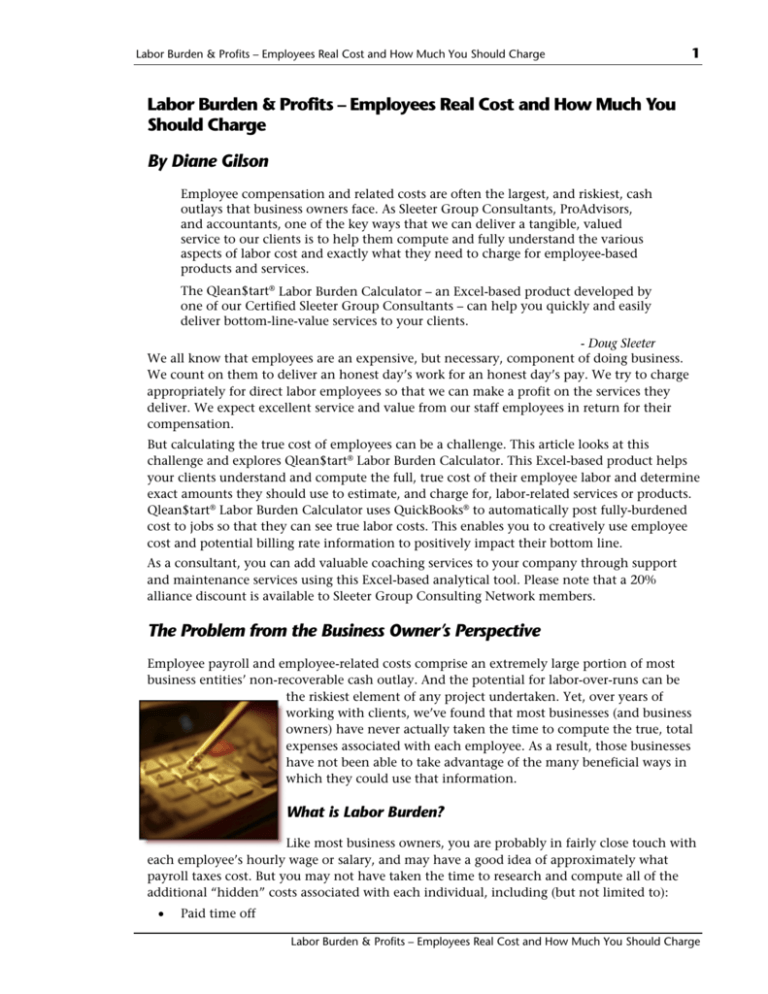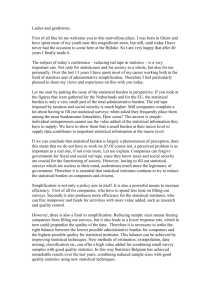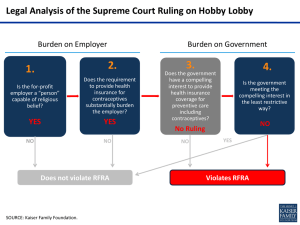Labor Burden & Profits
advertisement

Labor Burden & Profits – Employees Real Cost and How Much You Should Charge 1 Labor Burden & Profits – Employees Real Cost and How Much You Should Charge By Diane Gilson Employee compensation and related costs are often the largest, and riskiest, cash outlays that business owners face. As Sleeter Group Consultants, ProAdvisors, and accountants, one of the key ways that we can deliver a tangible, valued service to our clients is to help them compute and fully understand the various aspects of labor cost and exactly what they need to charge for employee-based products and services. The Qlean$tart® Labor Burden Calculator – an Excel-based product developed by one of our Certified Sleeter Group Consultants – can help you quickly and easily deliver bottom-line-value services to your clients. - Doug Sleeter We all know that employees are an expensive, but necessary, component of doing business. We count on them to deliver an honest day’s work for an honest day’s pay. We try to charge appropriately for direct labor employees so that we can make a profit on the services they deliver. We expect excellent service and value from our staff employees in return for their compensation. But calculating the true cost of employees can be a challenge. This article looks at this challenge and explores Qlean$tart® Labor Burden Calculator. This Excel-based product helps your clients understand and compute the full, true cost of their employee labor and determine exact amounts they should use to estimate, and charge for, labor-related services or products. Qlean$tart® Labor Burden Calculator uses QuickBooks® to automatically post fully-burdened cost to jobs so that they can see true labor costs. This enables you to creatively use employee cost and potential billing rate information to positively impact their bottom line. As a consultant, you can add valuable coaching services to your company through support and maintenance services using this Excel-based analytical tool. Please note that a 20% alliance discount is available to Sleeter Group Consulting Network members. The Problem from the Business Owner’s Perspective Employee payroll and employee-related costs comprise an extremely large portion of most business entities’ non-recoverable cash outlay. And the potential for labor-over-runs can be the riskiest element of any project undertaken. Yet, over years of working with clients, we’ve found that most businesses (and business owners) have never actually taken the time to compute the true, total expenses associated with each employee. As a result, those businesses have not been able to take advantage of the many beneficial ways in which they could use that information. What is Labor Burden? Like most business owners, you are probably in fairly close touch with each employee’s hourly wage or salary, and may have a good idea of approximately what payroll taxes cost. But you may not have taken the time to research and compute all of the additional “hidden” costs associated with each individual, including (but not limited to): • Paid time off Labor Burden & Profits – Employees Real Cost and How Much You Should Charge 2 Labor Burden & Profits – Employees Real Cost and How Much You Should Charge • Health insurance • Worker’s compensation insurance • Uniforms or special work clothes • Training • Usage of equipment and vehicles • Workspace (e.g., office or floor space) costs So how do we refer to these extra employee-related costs? Here are some of the terms and calculations frequently used by businesses who closely track employee costs: • Labor Burden: The costs, above and beyond gross compensation, that you incur in order for an employee to perform the work that you hired them to do. • Labor Burden Cost per Production Hour (or Fully-burdened Cost): (Labor Burden Cost + gross payroll labor cost) ÷ the number of actual work (production) hours. • Labor Burden Rate per Production Hour (%): The additional total labor burden cost, expressed as a percent, above and beyond regular hourly payroll. I.e., Labor Burden Cost per hour ÷ hourly payroll cost. After you compute an employee’s fully burdened labor cost and then divide it by the number of hours that employee actually works on projects, businesses often find that workers typically cost the company from 50% to 150% (or more) above their gross hourly labor rate. Understanding and carefully managing employment-related costs can make the critical difference between succeeding or failing in business. Employee’s True Costs Let’s look at an example. Pat’s hourly compensation is $17, or $35,360 gross annual payroll. As Pat’s employer, you do your research and find out that Pat has a variety of additional annualized costs attached to this position: • $3,005 for payroll taxes (based on 2.7% state unemployment on the first $9,000, and no other state disability taxes). • $3,536 for workers’ compensation insurance (at $10 per $100). • $4,200 for health insurance ($350 per month). • $1,060 for retirement benefits (3% of compensation). • $720 for cell, telephone and/or Internet costs ($60 per month). • $150 in uniforms (e.g., 4 company shirts at $25, 1 jacket at $50) or for office workers an equivalent amount in coffee. • $6,000 in company vehicle usage (depreciation, gas and oil, maintenance, license, insurance, etc.), or for office workers an equivalent amount in equipment usage and maintenance as well as office space. • $300 in small tools and equipment usage (at $25 per month) or for office workers an equivalent amount in office supplies. • $708 estimated annual bonus (2% of wages). • $100 employer-paid snacks, meals, parties, and entertainment. • $250 in training fees, seminars, etc. Total additional costs: $20,029. Labor Burden & Profits – Employees Real Cost and How Much You Should Charge Labor Burden & Profits – Employees Real Cost and How Much You Should Charge 3 Employee’s True Hours Next, let’s determine how many hours Pat is potentially available for company work. You’ll start with 52 weeks/year x 40 hours/week = 2,080 hours. Then you will subtract Pat’s non-project paid time for the year: • Six holidays. • 10 vacation days. • Six sick or personal days. • Two days of training seminars. This equals 24 days (192 hours), leaving 1,888 available working hours. You’ll then subtract an estimate of two hours from the 47 remaining work weeks for miscellaneous administrative meetings, timekeeping, general problem-solving or prep time and so forth (breaks are assigned to jobs or projects). This reduces the available production time by another 94 hours, leaving a total of 1,794 available working hours. The Final Results Pat’s additional Labor Burden Costs total just over $20,000. This brings Pat’s annual cost to $55,389. Labor Burden Cost per Production Hour (or Fully-burdened Cost) to your company is $30.87 per production/project hour ($55,389 ÷ 1,794 hours) or $0.51 per minute. To calculate Pat’s Labor Burden Rate (%) per Production (work) hour, subtract Pat’s hourly rate from his/her fully burdened cost ($30.87 - $17.00 = $13.87) and divide the excess by the base hourly rate ($13.87 ÷ $17.00). We see that our additional cost to have Pat on the job, when computed as a percentage, adds 82% to Pat’s base hourly rate. The bottom line: Pat is a truly costly and valuable asset whose time should be carefully assigned. And the related costs (and resulting contribution) should be closely measured and monitored. A Solution: Labor Burden Calculator Before I created the Labor Burden Calculator, I had construction industry clients who would call and ask me to help them calculate their true production costs for each employee. Since they didn't know how to compute those figures accurately, they had guessed at the amounts they should charge for their employees' time. Though they thought they were profitable on each job, when they tallied everything up they were losing money. These clients knew something was wrong with their job costing, and asked me to help. I computed my client's labor and labor burden costs by building a new spreadsheet and entered a lot of numbers, such as each employee's basic hourly rate, overtime hours, vacation, sick time, benefits, support costs, and more. I had to charge companies with multiple employees as much as $1,200-$1,500 (or more) for this customized consulting service, because it could take eight to ten button-pushing, spreadsheet-design hours to pound out each employee's real cost per hour. Once that was done, if we wanted to include those results in their job cost reports, we had to manually enter the results into QuickBooks using more calculations and lengthy, complicated journal entries. There had to be a better way. I searched but couldn't find a single product on the market that could help my clients. Labor Burden & Profits – Employees Real Cost and How Much You Should Charge 4 Labor Burden & Profits – Employees Real Cost and How Much You Should Charge Finally, I realized how to “trick” QuickBooks into posting my clients' additional labor burden costs into each job – automatically. Then I created and designed an efficient way to build the underlying employee costs and labor burden calculations. After four years and more than 300 hours of development, I created the Qlean$tart® Labor Burden Calculator. This Labor Burden Calculator offers two distinct solutions, the Calculator itself, and the QuickBooks posting technique. The Calculator can be used by anyone (regardless of their accounting software) who wants to understand their employee costs or who needs to increase the accuracy of their pricing model. The QuickBooks posting technique eliminated the need for timeconsuming, repetitive, and complex labor-burden computing and journal entries. Just provide QuickBooks with the data from the Calculator (using the method included with the product) and your labor burden costs will appear automatically as you post your regular payroll. 17 ways the Labor Burden Calculator can help the bottom line: 1. 2. 3. 4. 5. 6. 7. 8. 9. 10. 11. 12. 13. 14. 15. 16. 17. More accurately estimate job costs Price jobs to achieve desired profit margins Assist with standard costing calculations Assign the right employees to the right tasks Streamline the workflow by automatically assigning fully-burdened costs to jobs in QuickBooks® Head off labor over-runs before they get out of hand Determine when overtime can be beneficial Measure productivity and create objective employee goals and evaluation criteria Make better compensation and benefit decisions Compute the potential payback on improved office or production equipment Place a dollar value on hiring decisions Use fully-burdened employee cost results to make “Outsourcing” Decisions Review costs as workloads change Determine splits between direct labor and sales & admin labor costs Compute fully burdened labor costs for business owners Assist in determining inter-company employment cost assignments Help employees understand the value of their time and the cost of errors and wasted time The Labor Burden Calculator is easy for bookkeepers and business owners to use and learn. Many customers are able to get the calculator up and running within two hours, and every package includes specific instructions on how to integrate the Calculator's results into QuickBooks. Even though many clients are shocked when they see their employees’ cost results, they have confidence in the numbers because they have built them on their own. By seeing true employee production costs they have the specific information they need to more accurately price their jobs. Some clients share the results with their employees to help them see how valuable their time is as well as understand the reasons for the difference between their billing rate and their salary. Although I started by building this product for construction clients, any employee-based business can benefit from using this calculator, including (but not limited to) manufacturing, doctors', attorneys', and architects’ offices, tech support services, retail stores, banks, and a wide variety of other professional and technical services. A series of online demos to illustrate how the Calculator works can be viewed at http://www.infoplusacct.com/productdemo.html. Labor Burden & Profits – Employees Real Cost and How Much You Should Charge Labor Burden & Profits – Employees Real Cost and How Much You Should Charge 5 Adding Bottom Line Impact as a Trusted Business Advisor As an accountant, ProAdvisor, or consultant, Qlean$tart® Labor Burden Calculator can help you offer more to your clients. By creating and delivering on-target management and decision-making information you can integrate more effectively into your client’s management team. You can use the calculator to offer additional services that move you into the role of management advisor and financial resource by providing the types of value-added services that justify not only additional hours, but higher billing rates. The Labor Burden Calculator also enables you to create a standardized delivery system. You can offer a repeatable process that is cost-effective, understandable, and consistent. The spreadsheet provides a reliable method to provide accurate and clearly documented answers to your clients’ questions about labor costs that is both low-maintenance and easy to update. Finally, your clients will be more deeply involved and knowledgeable regarding their financial information (including production and employment costs), so they will not only survive, but prosper. Healthy, profitable clients who understand the value of the financial information that you help them achieve, are more likely to willingly ask for (and pay for), your services. 19 Ways to Support Your Clients with the Labor Burden Calculator Here are some of the ways you can use the Labor Burden Calculator to further your practice and help to improve your bottom line, as well as your client’s: 1. 2. 3. 4. 5. 6. 7. 8. 9. 10. Walk through some real-life examples and calculations with clients (even if they don’t currently perform job-costing) to illustrate why they need to thoroughly understand employment costs and that they must be carefully controlled if they are to achieve desired profit levels. Help your clients understand that their job costs are actually misleading unless the employment costs are properly burdened. Help your clients prepare their Reference Sheet and Labor Burden calculations the first time. Although they could technically do this themselves, many clients appreciate your assistance when completing the spreadsheet the first time. Help your clients iron out “unusual circumstances” related to employment cost calculations (e.g., employees split between different kinds of work, how to obtain underlying data, multi-locations, multi-pay levels, etc.). Help your clients understand the differences between different types of overhead (labor burden vs. “corporate overhead”). Create “results review” time to present results to, and consult with, company owners. They are typically extremely surprised. Also, they should also check the results for accuracy. Help your client organize their QuickBooks® Chart of Accounts and Payroll Items to split out compensation, payroll taxes, and burden/benefits between different types of employees (Direct, Sales, Admin, Owners). This immediately provides more useful management reports. Note: This will require periodic re-assignment of payroll taxes to specific accounts. You can create memorized reports and memorized transactions to assist with those entries. Help clients use the correct employment costs for Estimating so that their estimating process is more accurate and their Estimate vs. Actual reports will show “apples to apples”. This may include updating current estimating tools, and/or training estimators. Help clients understand and establish correct markups to achieve desired profit margins. (This may require your assistance in “weighting” different elements of individual job costs such as materials, subcontractors, other job costs, and labor.) In cooperation with the business owner or company management, you could coordinate a presentation for employees to illustrate the value of “production” time, Labor Burden & Profits – Employees Real Cost and How Much You Should Charge 6 Labor Burden & Profits – Employees Real Cost and How Much You Should Charge and the heavy cost of lost & wasted time. Note: Turn this into a light-hearted event by asking employees to provide data for a “sample employee”. If you are the presenter, it adds validity to the results and the owner doesn’t have play the “heavy” role. It sets the stage for subsequent meetings between the owner and individual employees when the employee’s specific costs and results should be discussed. 11. Help your clients use calculated burden results in their QuickBooks® file by: a. Using the payroll system. The payroll system is the “engine” that drives automatic burden postings. If they aren’t using this, and the information is important to them, you can help them set it up. b. Using job costing rates if they are using another method ($0 checks, etc.). c. Using the information as a primary driver in standard job costing (primarily for manufacturing applications). d. Establishing the correct Accounts and Payroll Items or Service Items needed for the process. e. Creating memorized reports and transactions to make the single, simple monthly entry (if required). 12. Help your clients establish a system to regularly review job cost reports. 13. Help clients fully understand the timing difference between time worked/time reports and when payroll & labor burden costs show up in reports. 14. Check regularly to see that they’ve updated their burden calculations and assist if they are behind. 15. Although results won’t be finalized until year-end, you can help to monitor amounts “over-allocated” or “under-allocated” on a year-to-date basis. At year-end, if the over or under-allocation is significant, you can assist by investigating reasons for the difference, and course-correct. 16. Assist with inter-company cost transfers and/or billing rates. 17. Assist with job hiring calculations and establishing employee production goals. 18. Assist with measuring actual employee production results. Often owners will ask for assistance in establishing productivity and bonus programs to incent employees. 19. Sleeter Group Consultant Network members can earn 20% on Labor Burden Calculators that you order for your clients (e-mail help@infoplusacct.com for information on the Alliance Program available to Sleeter Group members.) These kinds of burden analytics are the types of services that many high-priced industry consultants provide. You can use the Labor Burden Calculator to provide the same types of services – the big difference is that you can help your clients incorporate their results into their ongoing, day-to-day operations, in contrast with other consultants who may perform a one-time, on-the-side service, and who are then no longer available for ongoing support. And if you don’t want to provide any of these supporting services? Suggest to your client that they investigate and use the Labor Burden Calculator. If they do, you can be assured that they will become more knowledgeable and more aware of their employment costs and what they need to charge to achieve their desired profit margins! For a series of online demos to illustrate how the Calculator works, visit http://www.infoplusacct.com/productdemo.html. Diane C.O. Gilson, President, Info Plus(+) Accounting®, Inc. Diane is also a Certified Advanced QuickBooks ProAdvisor, Certified QuickBooks Enterprise ProAdvisor, and Certified Sleeter Group QuickBooks® Consultant. She is an author, trainer and construction accounting coach as well as a frequent speaker at The International Builders’ Show. Her firm (www.InfoPlusAcct.com), located in Ann Arbor, MI offers Internet-based QuickBooks® training and accounting support services for companies with a focus on job-costing. She is the developer of the Qlean$tart Worksheet: Labor Burden Calculator, an Excel worksheet designed to perform comprehensive labor burden calculations. To view on-line demos go to http://www.infoplusacct.com/productdemo.html. Contact Gilson via email at help@infoplusacct.com or contact her at 734-544-7620. Labor Burden & Profits – Employees Real Cost and How Much You Should Charge







